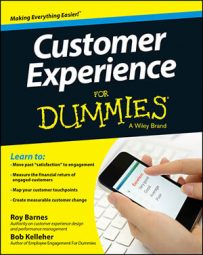For customer experience to be great, every interaction at every customer touchpoint must be exceptional. In other words, the whole organization must work together to deliver a great customer experience. There are eight essential components to building a great customer experience program:
Developing and deploying your customer experience intent statement
Building touchpoint maps
Redesigning touchpoints
Creating a dialogue with your customers
Building customer experience knowledge in the workforce
Recognizing and rewarding a job well done
Executing an integrated internal communications plan
Building a customer experience dashboard
Step 1: Developing and deploying your customer experience intent statement
The process of building your customer experience program starts here, with a formal declaration of your desired customer experience through an intent statement. The intent statement directs all subsequent work.
Although the intent statement is related to and supportive of brand positioning, it’s not a marketing slogan. The intent statement is more akin to a set of engineering schematics. It’s a formal, defined set of criteria against which the organization can manage and monitor the delivery of customer experience.
Step 2: Building touchpoint maps
If you want to provide excellent customer experience, you need a deep understanding of how your customers interact with your business at each of your individual touchpoints as well as across your entire organization. To gain this understanding, you must map your customer’s journey and the touchpoints they interact with along the way. This analysis provides you with a clearer understanding of your customers’ experience with your organization.
Step 3: Redesigning touchpoints
You’ll likely need to redesign one, some, or even all of your customer touchpoints to improve the experience your customers are receiving. Fortunately, the redesign process for each touchpoint requires just four weeks, or 20 workdays. No more, no less. (Due to an alarmingly prevalent bureaucratic condition — CADD, or corporate attention deficit disorder — redesign efforts must be very tightly scoped and time-limited.)
During this period, the touchpoint redesign team brainstorms, proposes change, and executes on its proposal. In addition to creating change fast, this process also results in a widely dispersed set of enthusiastic customer experience change leaders.
Step 4: Creating a dialogue with your customers
When it comes to getting feedback from customers, annual surveys are out, and constant listening and providing real-time dialogue is in. That means you need to inventory where you are listening effectively today, prioritizing your highest-value listening and dialogue touchpoints, and creating a governance model for managing and responding to customer feedback.
The end game here is to be able to converse with your customers in near real-time and to respond to customer concerns, problems, and suggestions as they happen.
Step 5: Building customer experience knowledge in the workforce
Employees who regularly interact with customers need to understand not only what customer experience your organization intends to deliver (your intent statement), but also how to deliver that experience. Most employees are trained only on the specific functions needed to execute their individual part of their siloed business process.
Very few are given real-world, hands-on, practical experience in exactly how to deliver great customer experience. That has to change!
Step 6: Recognizing and rewarding customer experience done well
Your organization’s compensation system telegraphs to all employees what’s really important and what isn’t. If rewards (compensation and so forth) and recognition programs don’t reflect your focus on customer experience, then even your very best efforts to turn your company’s culture customer-centric will ultimately fail. The program will also fail if you reward individuals who “make their numbers” but act in a way that ignores or injures the customer experience.
Step 7: Executing an integrated internal communications plan
If your organization’s leaders rarely mention customer concerns, issues, or opportunities, then all the best internal marketing will fall short of fostering significant cultural change. The fact is, making your organization customer-centric is an uphill battle. It is winnable, but significant resources — both financial and philosophical — need to be brought to bear, including a robust internal communications effort.
Step 8: Building a customer experience dashboard
Feel-good customer initiatives are a no-go. These must be replaced with laser-guided projects supported by clear and formal performance metrics with assigned and owned commitments. Real metrics and aggressive goals drive accountability for improvement and help kill misaligned initiatives.
To help you keep track of your metrics and data, you’ll want to build a highly visible customer experience dashboard and to regularly monitor, review, and discuss each measure it contains.

